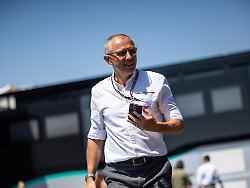“Unless Meteor Strikes”
F1 boss doesn’t believe in female drivers in premier class
08/25/2022, 12:12 p.m
Only two women have competed in Grands Prix in the history of Formula 1. Motorsport is male-dominated, even if there are female development drivers. The head of the racing series, Stefano Domenicali, is certain that it will stay that way.
Formula 1 boss Stefano Domenicali does not expect a driver to advance to the racing series in the coming years. “Realistically, I don’t expect a woman to get into Formula 1 in the next five years unless something like a meteor strikes. That’s very unlikely,” said the Italian before the Belgian Grand Prix at the weekend. The managing director emphasized that Formula 1 is trying to improve the chances for female drivers. It is “crucial to give women the maximum opportunity on the way to Formula 1,” said Domenicali.
In the history of the racing series only two women have taken part in a Grand Prix, both from Italy. Maria Teresa de Filippis qualified for three races in the 1950s. Lella Lombardi is the only racing driver to have made it into the points. In 1975 she got half a point in sixth place in an abandoned Grand Prix.
Susie Wolff, on the other hand, was very close, but ultimately never got the chance to drive a race at Williams. From 2012 to 2015 she was the team’s development driver and was also used for test and training drives. At the 2014 British Grand Prix at Silverstone, she became the first woman to compete in a Formula 1 weekend since 1992 when Giovanna Amati had tried unsuccessfully to qualify three times.
In July 2014, she also took part in the free practice session at the Hockenheimring, finishing 15th out of 22 participants and only two tenths slower than her teammate Felipe Massa. Her husband, Mercedes team boss Toto Wolff, recently said in retrospect to the “Financial Times”: “She was denied her last chance.” The reason for this is that Williams “never dared to make this decision”.
Chadwick dominates the W Series
Formula 1 currently supports the W Series, a racing series for women that is run as part of some Grand Prix events. “We are working on improving the system. We will present measures shortly,” said Domenicali. Jamie Chadwick has dominated events there since the W Series has existed. Like Wolff back then, the 24-year-old is now a development driver at Williams. The Brit is most likely to be trusted to make the leap into Formula 1. So far, none of the drivers has been poached from Formula 3 or Formula 2.
In Formula 2 there is a new woman at the start: Tatiana Calderón. The 29-year-old competes for Charouz Racing System. The Colombian was already active in the racing series in 2019. This makes Calderón the highest starting woman in motorsport.
Sophia Flörsch already drove in Formula 3, who repeatedly emphasizes that she would like to start in Formula 1. The German was best known for her serious accident at the Macau race in 2018, when she collided with a competitor at almost 300 kilometers per hour, took off, flew far through the air and finally crashed into a podium. She suffered several broken vertebrae but made her comeback the following year. After races in the DTM, she now competes in the 24 Hours of Le Mans.
Flörsch has a clear opinion on the opportunities for women in motorsport. “It’s increasingly the older generation that doesn’t support a woman being successful in Formula 1,” she told Deutsche Welle in March. “It’s the generation that already has white hair on their heads. They come from a different time. There’s this image of a tough, sweaty, hard-fought racing driver who has to be a man. In their eyes, that can’t be change.”
After all, the FIA has had a funding project for two years to get girls excited about racing. “FIA Girls On Track” is intended to “inspire the next generation of young girls,” explained Ambassador Wolff. “We want to ensure that they are supported by role models and mentoring in sport.” She knows best how difficult it is to get to the top.
